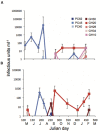Pseudo-nitzschia Challenged with Co-occurring Viral Communities Display Diverse Infection Phenotypes
- PMID: 27148216
- PMCID: PMC4837327
- DOI: 10.3389/fmicb.2016.00527
Pseudo-nitzschia Challenged with Co-occurring Viral Communities Display Diverse Infection Phenotypes
Abstract
Viruses are catalysts of biogeochemical cycling, architects of microbial community structure, and terminators of phytoplankton blooms. Viral lysis of diatoms, a key group of eukaryotic phytoplankton, has the potential to impact carbon export and marine food webs. However, the impact of viruses on diatom abundance and community composition is unknown. Diatom-virus dynamics were explored by sampling every month at two coastal and estuarine locations in Washington state, USA resulting in 41 new isolates of the pennate diatom Pseudo-nitzschia and 20 environmental virus samples. We conducted a total of 820 pair-wise crosses of the Pseudo-nitzschia isolates and viral communities. Viral communities infected Pseudo-nitzschia isolates in 8% of the crosses overall and 16% of crosses when the host and viral communities were isolated from the same sample. Isolates ranged in their permissivity to infection with some isolates not infected by any viral samples and others infected by up to 10 viral communities. Isolates that were infected by the most viral communities also had the highest maximum observed viral titers (as high as 16000 infectious units ml(-1)). Titers of the viral communities were host dependent, as titers for one viral sample on eight different hosts spanned four orders of magnitude. Sequencing of the Pseudo-nitzschia Internal Transcribed Spacer 1 (ITS1) of the revealed multiple subgroups of hosts with 100% ITS1 identities that were infected by different viral communities. Indeed, we repeatedly isolated groups of isolates with identical ITS1 sequences from the same water sample that displayed different viral infection phenotypes. The interactions between Pseudo-nitzschia and the viral communities highlight the diversity of diatoms and emphasize the complexity and variability of diatom-virus dynamics in the ocean.
Keywords: Pseudo-nitzschia; diatom; harmful algal bloom; microdiversity; phytoplankton; titer; virus.
Figures






Similar articles
-
Emerging phylogeographic perspective on the toxigenic diatom genus Pseudo-nitzschia in coastal northern European waters and gateways to eastern Arctic seas: Causes, ecological consequences and socio-economic impacts.Harmful Algae. 2023 Nov;129:102496. doi: 10.1016/j.hal.2023.102496. Epub 2023 Oct 7. Harmful Algae. 2023. PMID: 37951606
-
INTER- AND INTRASPECIFIC COMMUNITY STRUCTURE WITHIN THE DIATOM GENUS PSEUDO-NITZSCHIA (BACILLARIOPHYCEAE).J Phycol. 2008 Jun;44(3):10.1111/j.1529-8817.2008.00518.x. doi: 10.1111/j.1529-8817.2008.00518.x. J Phycol. 2008. PMID: 24376283 Free PMC article.
-
Phytoplankton-Associated Bacterial Community Composition and Succession during Toxic Diatom Bloom and Non-Bloom Events.Front Microbiol. 2016 Sep 12;7:1433. doi: 10.3389/fmicb.2016.01433. eCollection 2016. Front Microbiol. 2016. PMID: 27672385 Free PMC article.
-
Pseudo-nitzschia, Nitzschia, and domoic acid: New research since 2011.Harmful Algae. 2018 Nov;79:3-43. doi: 10.1016/j.hal.2018.06.001. Epub 2018 Oct 27. Harmful Algae. 2018. PMID: 30420013 Review.
-
A decade and a half of Pseudo-nitzschia spp. and domoic acid along the coast of southern California.Harmful Algae. 2018 Nov;79:87-104. doi: 10.1016/j.hal.2018.07.007. Epub 2018 Aug 10. Harmful Algae. 2018. PMID: 30420020 Review.
Cited by
-
Assessing the relative importance of stressors to the benthic index, M-AMBI: An example from U.S. estuaries.Mar Pollut Bull. 2023 Jan;186:114456. doi: 10.1016/j.marpolbul.2022.114456. Epub 2022 Dec 8. Mar Pollut Bull. 2023. PMID: 36502776 Free PMC article.
-
Spatiotemporal transitions in Pseudo-nitzschia species assemblages and domoic acid along the Alaska coast.PLoS One. 2023 Mar 22;18(3):e0282794. doi: 10.1371/journal.pone.0282794. eCollection 2023. PLoS One. 2023. PMID: 36947524 Free PMC article.
-
Expanding the toolbox for cryopreservation of marine and freshwater diatoms.Sci Rep. 2018 Mar 9;8(1):4279. doi: 10.1038/s41598-018-22460-0. Sci Rep. 2018. PMID: 29523856 Free PMC article.
-
Reduced representation sequencing accurately quantifies relative abundance and reveals population-level variation in Pseudo-nitzschia spp.Harmful Algae. 2022 Oct;118:102314. doi: 10.1016/j.hal.2022.102314. Epub 2022 Sep 5. Harmful Algae. 2022. PMID: 36195429 Free PMC article.
-
Evaluation of the rbcL marker for metabarcoding of marine diatoms and inference of population structure of selected genera.Front Microbiol. 2023 Mar 2;14:1071379. doi: 10.3389/fmicb.2023.1071379. eCollection 2023. Front Microbiol. 2023. PMID: 36950161 Free PMC article.
References
-
- Babson A. L., Kawase M., MacCready P. (2006). Seasonal and interannual variability in the circulation of puget sound, Washington: a box model study. Atmosphere-Ocean 44 29–45. 10.3137/ao.440103 - DOI
-
- Bates S. S., Bird C. J., de Freitas S. W., Foxall R., Gilgan M., Hanic L. A., et al. (1989). Pennate diatom Nitzschia pungense as the primary source of domoic acid, a toxin in the shellfish from Eastern Prince Edward Island, Canada. Can. Fish J. Aquat. Sci. 46 1203–1215. 10.1139/f89-156 - DOI
Grants and funding
LinkOut - more resources
Full Text Sources
Other Literature Sources

